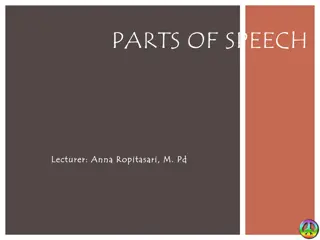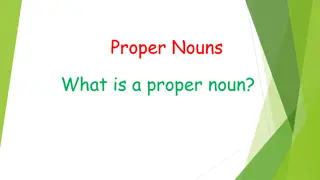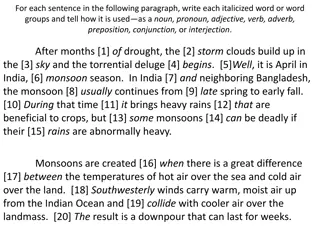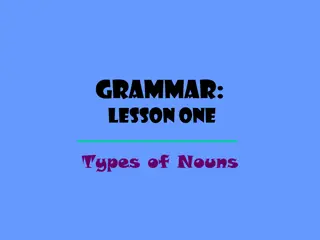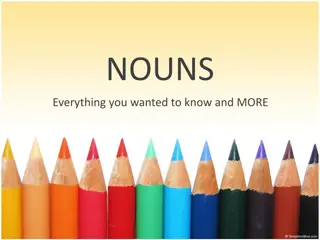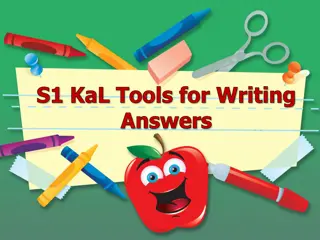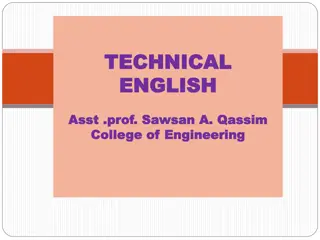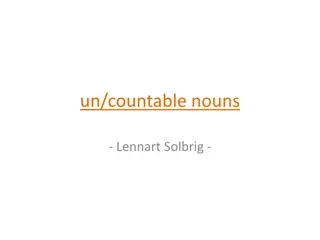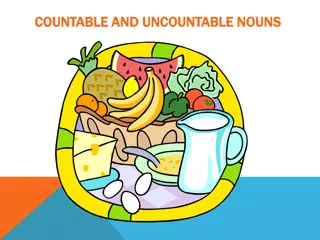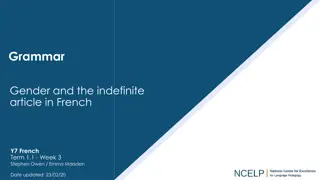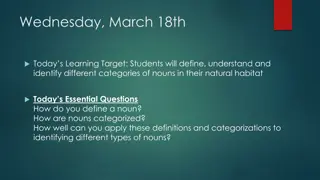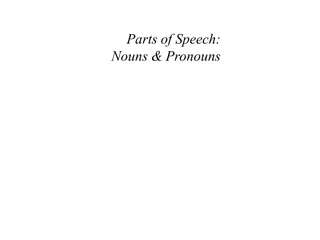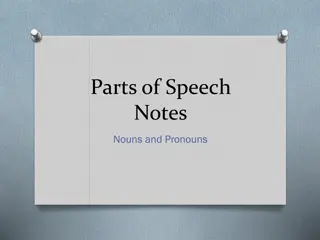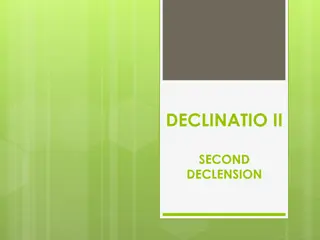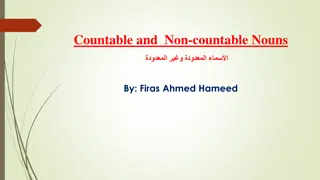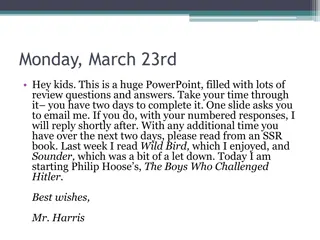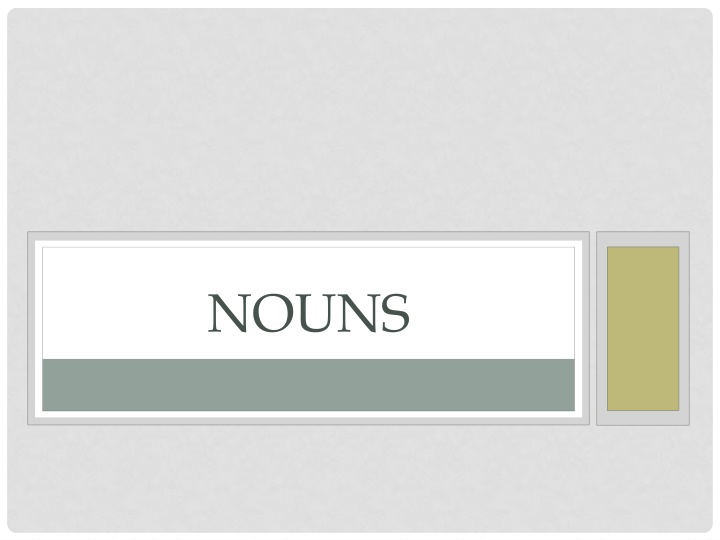
Nouns: Types and Examples
Discover the world of nouns with examples and explanations. Learn about common nouns, proper nouns, compound nouns, singular to plural changes, collective nouns, and more. Enhance your language skills and improve your grammar knowledge with this comprehensive guide.
Uploaded on | 1 Views
Download Presentation

Please find below an Image/Link to download the presentation.
The content on the website is provided AS IS for your information and personal use only. It may not be sold, licensed, or shared on other websites without obtaining consent from the author. If you encounter any issues during the download, it is possible that the publisher has removed the file from their server.
You are allowed to download the files provided on this website for personal or commercial use, subject to the condition that they are used lawfully. All files are the property of their respective owners.
The content on the website is provided AS IS for your information and personal use only. It may not be sold, licensed, or shared on other websites without obtaining consent from the author.
E N D
Presentation Transcript
NOUNS A noun is word or group of words that is used to name a person, place, thing or idea. Persons: veterinarian, leaders, sisters, Dr. Robinson, Americans Places: classroom, kennel, Lake Mead, Bunker Hill Things: bumblebee, notebook, Statue of Liberty, collar Ideas: honesty, willingness, self-esteem, freedom Example: 1. The teacher gave homework to the class. 2. Many dogs enjoy walks. 3. The honesty of the boy was appreciated. (Practice pg. 296)
CHANGING SINGULAR NOUNS TO PLURAL Add s Add es Change the y to I and and es Change the spelling of the word (word change) Change the f to v and add es Vowel plus y and add s Sometimes the word stays the same (no change)
CHANGING SINGULAR NOUNS TO PLURAL. ocean balloon hotel peach dress brush box penny party baby foot tooth mouse child half knife leaf shelf wife day key tray play monkey elk moose trout deer salmon sheep
COLLECTIVE NOUNS A collective noun is a noun that names a group of people, animals, or things. *** You are not just adding an s to make the noun plural! These nouns actually mean a group of something *** Examples: People: crew, family, staff, committee Animals: swarm, herd, pack, colony Things: clump, stack, bundle, set 1. 2. 3. The club meets every Saturday in the library. Did you encounter a school of angelfish while scuba diving? This small pitcher is part of that antique set.
COMPOUND NOUNS A compound noun is a noun made up of two or more words. There are three types of compound nouns. Separate Words post office, Golden Gate Bridge, middle school Hyphenated Words daughter-in-law, warm-up, left- hander Combined Words basketball, railroad, doorknob 1. 2. 3. (Practice pg 298 ex.3-4) My great-uncle arrived from Canada today. I found a lost dog in the parking lot behind the school. The classroom is down the hall on the right-hand side.
COMMON & PROPER NOUNS A common noun names any one of a group of people, places, or things. It is not specific and it is not generally capitalized unless at the beginning of a sentence. A proper noun names a specific person, place, or thing. Proper nouns are ALWAYS capitalized. Examples: Common: writer, desk, document, duck, child Proper: Declaration of Independence, Argentina, Mary Wilson 1. 2. 3. 4. The dog ran out of the yard. Many Americans are truly patriotic. Walt Disney World is a wonderful place for a family vacation. Parks are a great place for exercise. (Practice pg 299 ex. 5)
ABSTRACT NOUNS An abstract noun is a noun that cannot be detected by the five senses. An abstract noun names an idea, feeling, emotion, quality or characteristic. Examples: sadness, education, love, speed, beauty, communication, happiness 1. She captured our interest with her enthusiasm. 2. The loneliness was too much to handle. 3. The mountain presented a challenge to the hikers.
CONCRETE NOUNS A concrete noun is a person, animal, place, or thing that you can sense with your five senses. (sight, hearing, taste, touch, smell) Examples: computer, books, smoke, perfume, siren, bookcase 1. My clients and I ate dinner at the restaurant. 2. After some careful thought, the boy purchased the book. 3. Blindfish live in dark caves and underground streams.
PREDICATE NOUNS AND PRONOUNS Predicate noun or predicate pronoun follows a linking verb and renames or identifies the subject A predicate noun or predicate pronoun is never the object of the preposition. Incorrect ex: Steve Young was one of football s superstars. superstars is an object of the preposition of it is not a predicate noun. Correct ex: The largest lizard is the Komodo dragon. dragon is the predicate noun because it identifies the noun lizard.
COMMON LINKING VERBS am Are Is Was Were am being are being should be is being was being would be were beingwould have been taste turn can be could be may be might be must be shall be have been appear has been had been could have been grow may have been might have been remain must have been should have been smell will have been become feel look seem will be sound stay
DIRECT OBJECTS A direct object is a noun or pronoun that receives the action of a verb. You can find the direct object by asking What? or Whom? after an action verb. Ex: My older brother found a grass snake. Found what? A grass snake Ex: I told Ricky not to take it home. Told whom? Ricky
COMPOUND DIRECT OBJECTS Direct objects can be compound, meaning one verb can have two or more direct objects. Ex: The lizard eats crickets and other bugs. Eats what? Crickets and bugs Ex: The committee chose Frank, Tommy, and Bill to go to the show. Chose whom? Frank, Tommy, and Bill Practice: pg. 412 ex. 35 & 36
INDIRECT OBJECT An indirect object is a noun or pronoun that comes after an action verb and before a direct object. It names the person or thing that something is given to or done for. Always looks for the direct object first, then look to see if there is an indirect object before it. Indirect objects answer the questions To or For whom? To or For what? after the action verb.
Ex: Lucy told him the news. Direct object: Told what? news Indirect object: Told to whom? him Ex: I gave each paper a number. Direct object: Gave what? Number Indirect object: Gave to what? Paper Most sentences with indirect objects will follow the same pattern: subject + action verb + indirect object + direct object
COMPOUND INDIRECT OBJECTS Indirect objects can also be compound, meaning they have two or more indirect objects in the sentence. Ex: He gave his lizard and turtle their food. Direct object: Gave what? Food Indirect objects: Gave to what: lizard, turtle (He + gave + lizard , turtle + food) Practice: pg. 415 ex. 38 &39
APPOSITIVES An appositive is a noun or a pronoun placed beside another noun or pronoun to identify or describe it. Ex. My teacher Mr. Craig enjoys books by Jane Austin. (The appositive Mr. Craig identifies the noun teacher.) Ex. Mr. Craig wishes he could go back in time to talk to one author, her. (The appositive her identifies the noun author.)
AN APPOSITIVE PHRASE CONSISTS OF AN APPOSITIVE AND ITS MODIFIERS. Ex. Anne, a goodhearted and intelligent woman, must learn not to be too easily persuaded by others. (The appositive phrase a goodhearted and intelligent woman adds descriptive information that is unnecessary to the sentence s basic meaning, so it is set off by commas.) Ex. Anne s friend Lady Russell sometimes gives Anne poor advice. (Anne has more than one friend. The appositive Lady Russell tells you which friend is meant, so it is not set off by commas.) Do textbook pg. 107 ex. 14 for practice.
POSSESSIVE NOUNS Possessive shows ownership To form the possessive case of a singular noun, add s Ex. A boy s cap Lucy s ball the dog s toy A proper noun ending in s may only take an at the end Ex. The Philippines government Mr. Rodgers cat Plural nouns not ending in s receives an s at the end Ex. Mice s tracks men s hats children s games Plural nouns already ending in s just add the apostrophe. Ex. Cats basket four days delay brushes bristles

